CMS 101 Wiki Project: A Project Management View on E-books Impact
VerifiedAdded on 2023/05/28
|6
|927
|233
Project
AI Summary
This project provides an overview of e-books, tracing their origins from early mechanical text readers to the digital formats we use today. It highlights key figures like Ángela Ruiz Robles and Michael Hart, and discusses the impact of the internet and PDF format on e-book accessibility. The project also examines the adoption of e-textbooks in K-12 and higher education, noting the importance of performance expectancy and perceived enjoyment in student acceptance. Drawing from various research articles, this project contributes to a CMS 101 Wiki, offering insights into the evolution, benefits, and critical factors influencing the use of e-books in education and media studies. Desklib provides a platform to explore more such assignments and study resources.
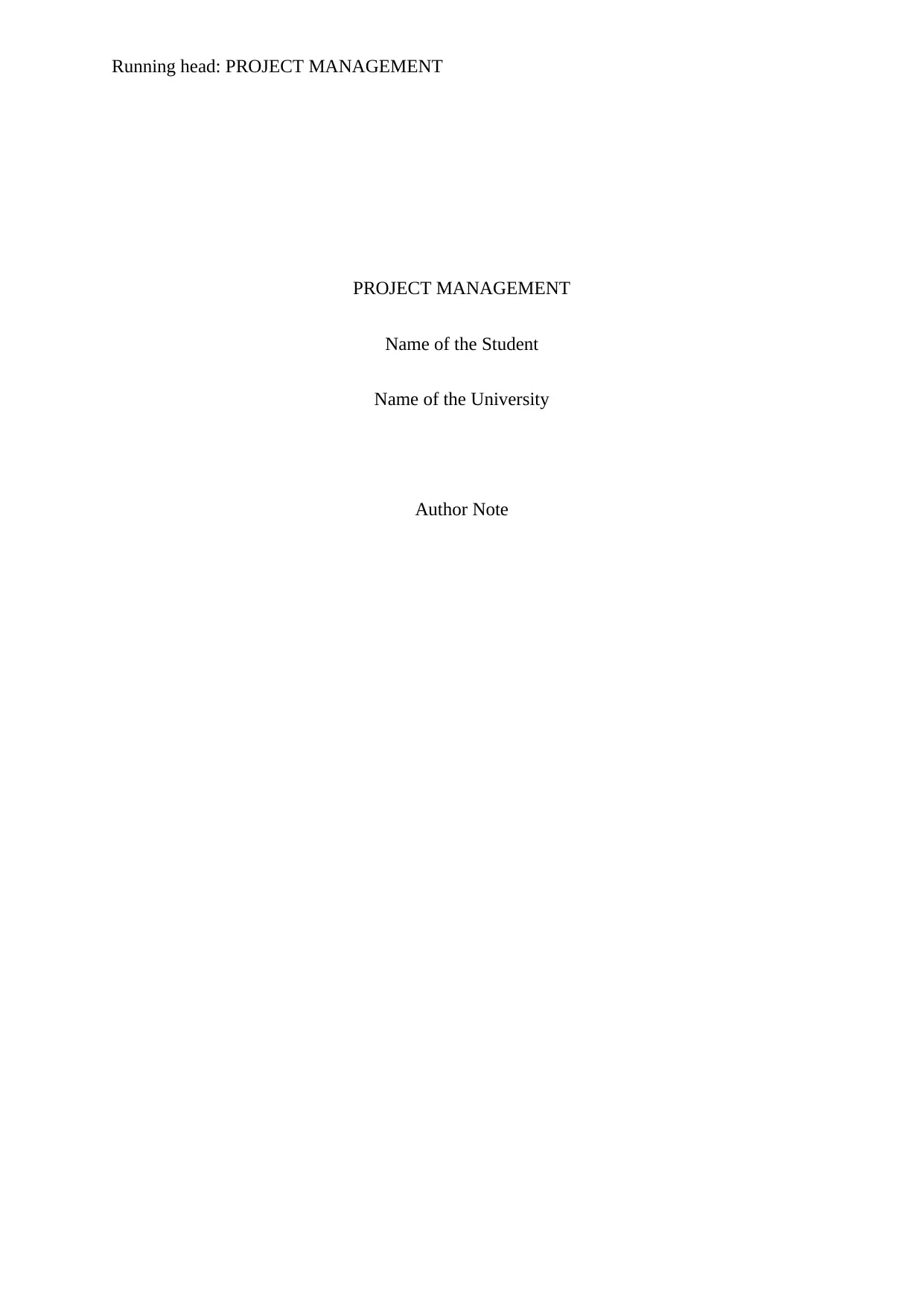
Running head: PROJECT MANAGEMENT
PROJECT MANAGEMENT
Name of the Student
Name of the University
Author Note
PROJECT MANAGEMENT
Name of the Student
Name of the University
Author Note
Paraphrase This Document
Need a fresh take? Get an instant paraphrase of this document with our AI Paraphraser
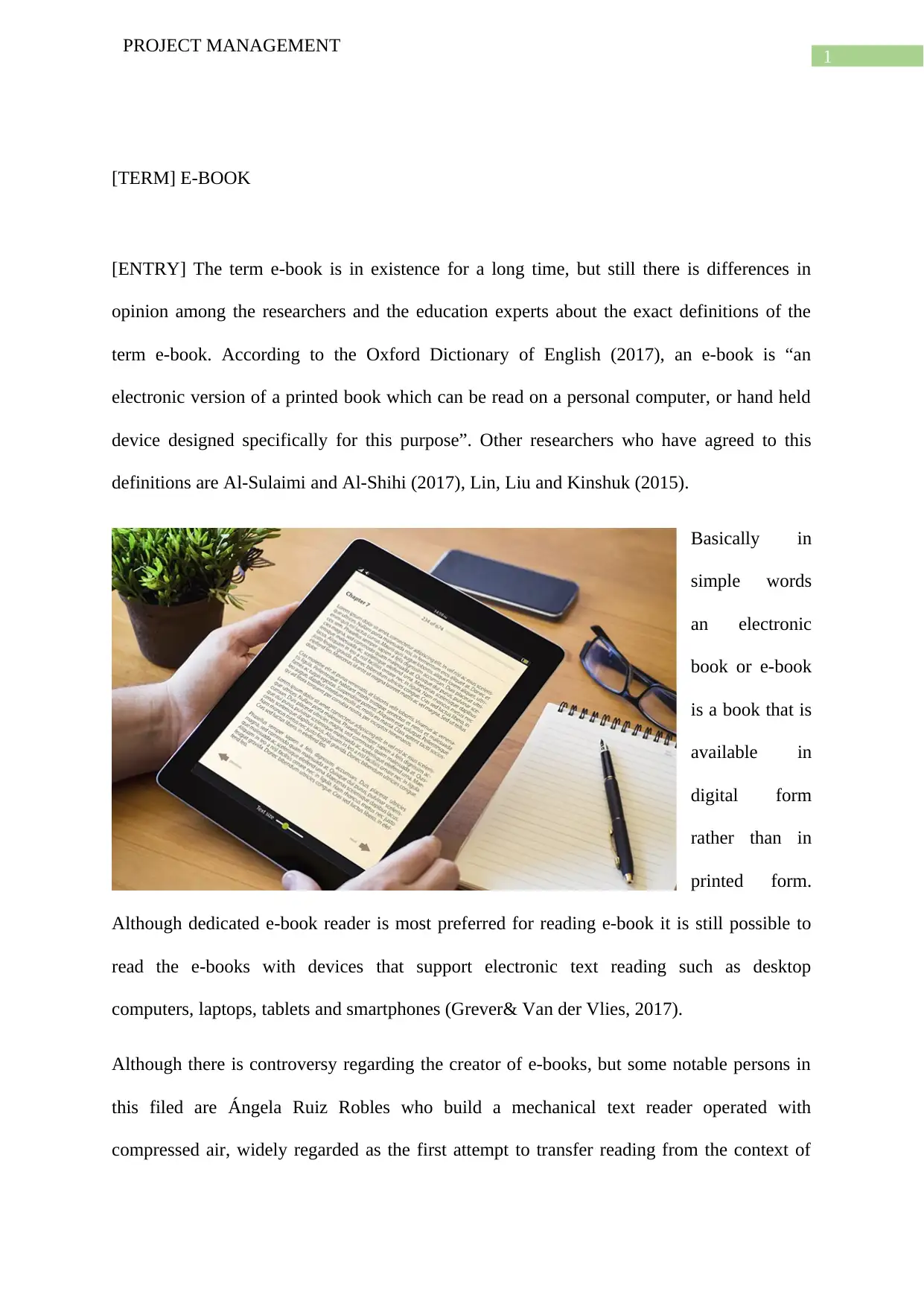
1
PROJECT MANAGEMENT
[TERM] E-BOOK
[ENTRY] The term e-book is in existence for a long time, but still there is differences in
opinion among the researchers and the education experts about the exact definitions of the
term e-book. According to the Oxford Dictionary of English (2017), an e-book is “an
electronic version of a printed book which can be read on a personal computer, or hand held
device designed specifically for this purpose”. Other researchers who have agreed to this
definitions are Al-Sulaimi and Al-Shihi (2017), Lin, Liu and Kinshuk (2015).
Basically in
simple words
an electronic
book or e-book
is a book that is
available in
digital form
rather than in
printed form.
Although dedicated e-book reader is most preferred for reading e-book it is still possible to
read the e-books with devices that support electronic text reading such as desktop
computers, laptops, tablets and smartphones (Grever& Van der Vlies, 2017).
Although there is controversy regarding the creator of e-books, but some notable persons in
this filed are Ángela Ruiz Robles who build a mechanical text reader operated with
compressed air, widely regarded as the first attempt to transfer reading from the context of
PROJECT MANAGEMENT
[TERM] E-BOOK
[ENTRY] The term e-book is in existence for a long time, but still there is differences in
opinion among the researchers and the education experts about the exact definitions of the
term e-book. According to the Oxford Dictionary of English (2017), an e-book is “an
electronic version of a printed book which can be read on a personal computer, or hand held
device designed specifically for this purpose”. Other researchers who have agreed to this
definitions are Al-Sulaimi and Al-Shihi (2017), Lin, Liu and Kinshuk (2015).
Basically in
simple words
an electronic
book or e-book
is a book that is
available in
digital form
rather than in
printed form.
Although dedicated e-book reader is most preferred for reading e-book it is still possible to
read the e-books with devices that support electronic text reading such as desktop
computers, laptops, tablets and smartphones (Grever& Van der Vlies, 2017).
Although there is controversy regarding the creator of e-books, but some notable persons in
this filed are Ángela Ruiz Robles who build a mechanical text reader operated with
compressed air, widely regarded as the first attempt to transfer reading from the context of
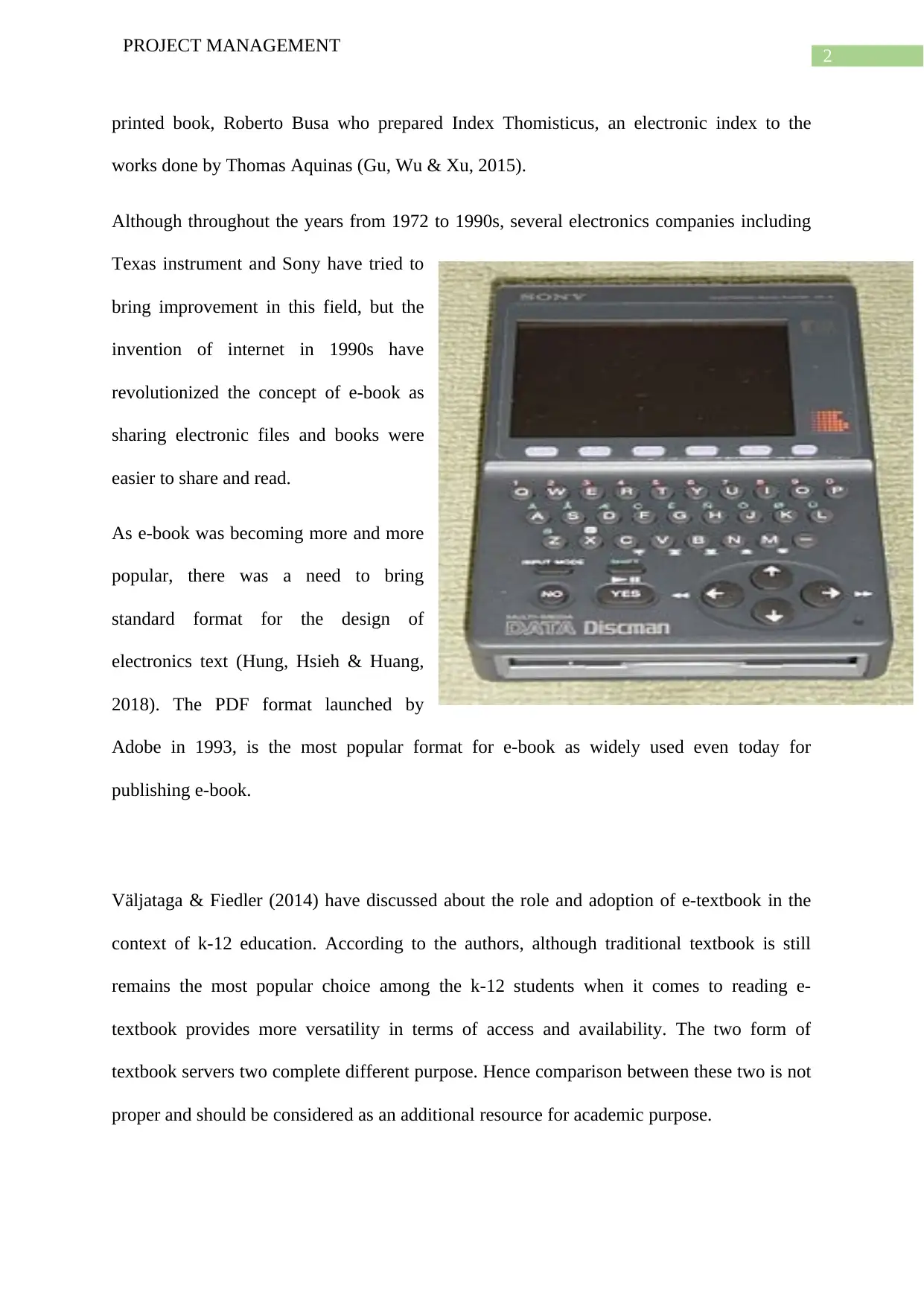
2
PROJECT MANAGEMENT
printed book, Roberto Busa who prepared Index Thomisticus, an electronic index to the
works done by Thomas Aquinas (Gu, Wu & Xu, 2015).
Although throughout the years from 1972 to 1990s, several electronics companies including
Texas instrument and Sony have tried to
bring improvement in this field, but the
invention of internet in 1990s have
revolutionized the concept of e-book as
sharing electronic files and books were
easier to share and read.
As e-book was becoming more and more
popular, there was a need to bring
standard format for the design of
electronics text (Hung, Hsieh & Huang,
2018). The PDF format launched by
Adobe in 1993, is the most popular format for e-book as widely used even today for
publishing e-book.
Väljataga & Fiedler (2014) have discussed about the role and adoption of e-textbook in the
context of k-12 education. According to the authors, although traditional textbook is still
remains the most popular choice among the k-12 students when it comes to reading e-
textbook provides more versatility in terms of access and availability. The two form of
textbook servers two complete different purpose. Hence comparison between these two is not
proper and should be considered as an additional resource for academic purpose.
PROJECT MANAGEMENT
printed book, Roberto Busa who prepared Index Thomisticus, an electronic index to the
works done by Thomas Aquinas (Gu, Wu & Xu, 2015).
Although throughout the years from 1972 to 1990s, several electronics companies including
Texas instrument and Sony have tried to
bring improvement in this field, but the
invention of internet in 1990s have
revolutionized the concept of e-book as
sharing electronic files and books were
easier to share and read.
As e-book was becoming more and more
popular, there was a need to bring
standard format for the design of
electronics text (Hung, Hsieh & Huang,
2018). The PDF format launched by
Adobe in 1993, is the most popular format for e-book as widely used even today for
publishing e-book.
Väljataga & Fiedler (2014) have discussed about the role and adoption of e-textbook in the
context of k-12 education. According to the authors, although traditional textbook is still
remains the most popular choice among the k-12 students when it comes to reading e-
textbook provides more versatility in terms of access and availability. The two form of
textbook servers two complete different purpose. Hence comparison between these two is not
proper and should be considered as an additional resource for academic purpose.
⊘ This is a preview!⊘
Do you want full access?
Subscribe today to unlock all pages.

Trusted by 1+ million students worldwide
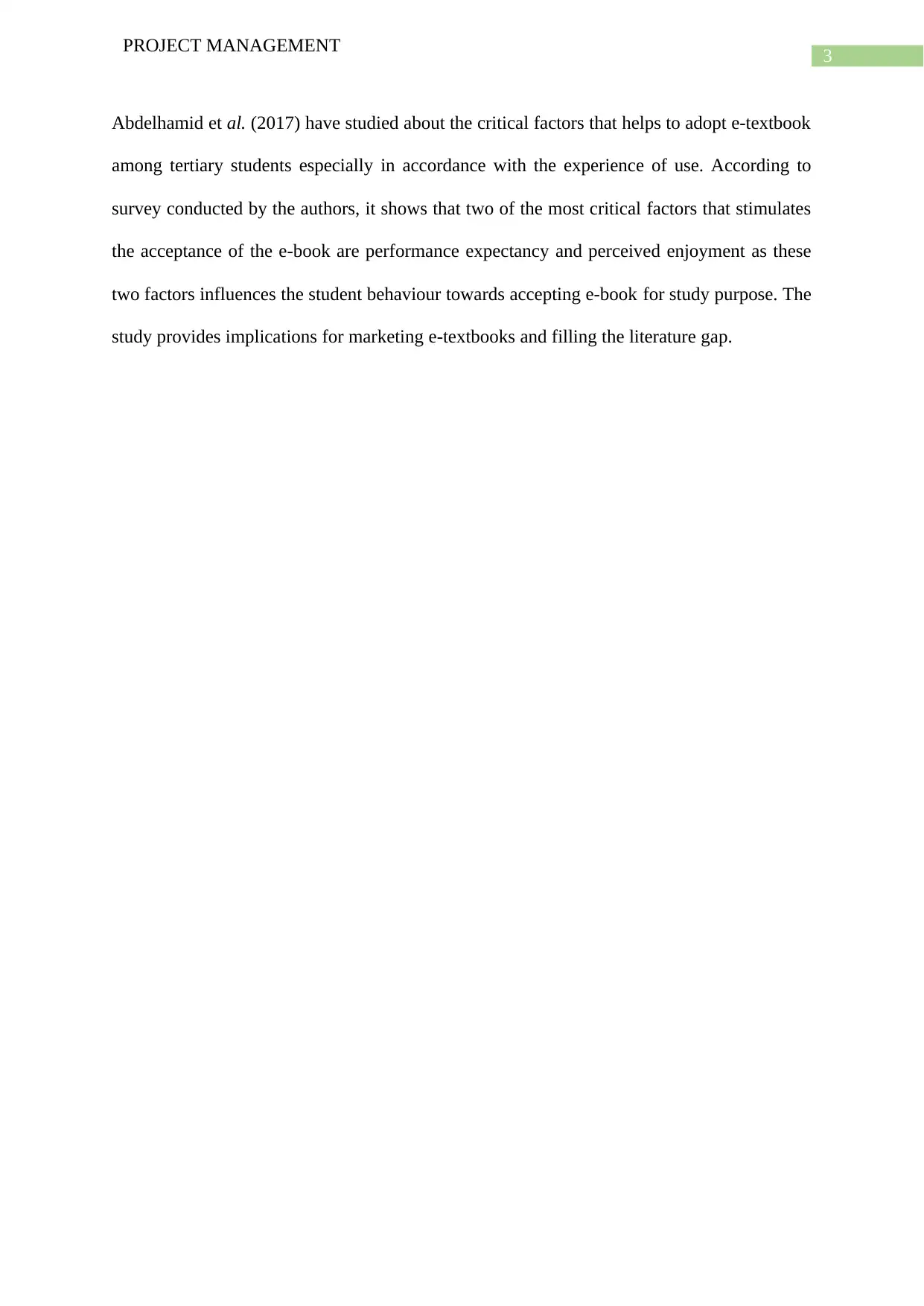
3
PROJECT MANAGEMENT
Abdelhamid et al. (2017) have studied about the critical factors that helps to adopt e-textbook
among tertiary students especially in accordance with the experience of use. According to
survey conducted by the authors, it shows that two of the most critical factors that stimulates
the acceptance of the e-book are performance expectancy and perceived enjoyment as these
two factors influences the student behaviour towards accepting e-book for study purpose. The
study provides implications for marketing e-textbooks and filling the literature gap.
PROJECT MANAGEMENT
Abdelhamid et al. (2017) have studied about the critical factors that helps to adopt e-textbook
among tertiary students especially in accordance with the experience of use. According to
survey conducted by the authors, it shows that two of the most critical factors that stimulates
the acceptance of the e-book are performance expectancy and perceived enjoyment as these
two factors influences the student behaviour towards accepting e-book for study purpose. The
study provides implications for marketing e-textbooks and filling the literature gap.
Paraphrase This Document
Need a fresh take? Get an instant paraphrase of this document with our AI Paraphraser
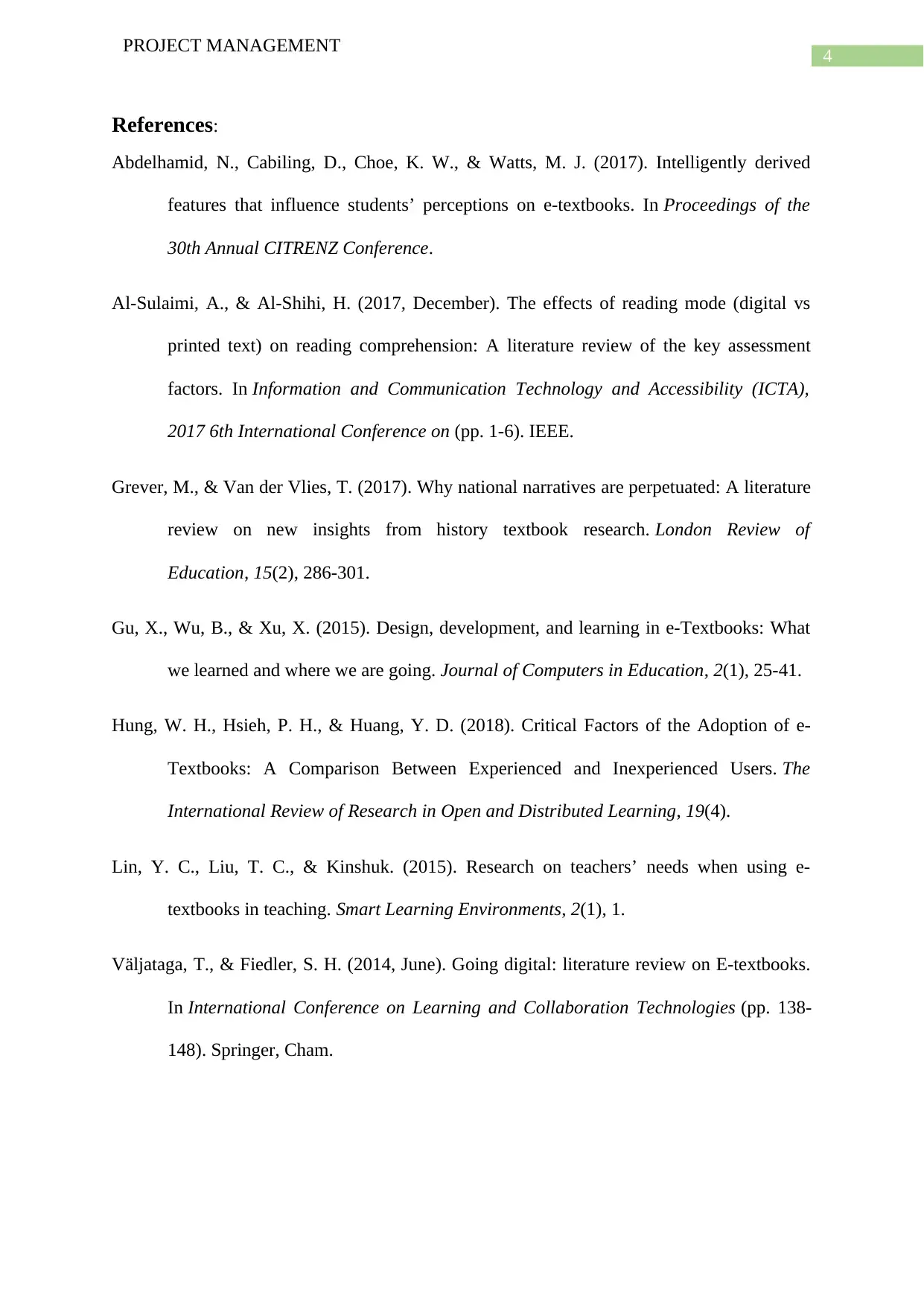
4
PROJECT MANAGEMENT
References:
Abdelhamid, N., Cabiling, D., Choe, K. W., & Watts, M. J. (2017). Intelligently derived
features that influence students’ perceptions on e-textbooks. In Proceedings of the
30th Annual CITRENZ Conference.
Al-Sulaimi, A., & Al-Shihi, H. (2017, December). The effects of reading mode (digital vs
printed text) on reading comprehension: A literature review of the key assessment
factors. In Information and Communication Technology and Accessibility (ICTA),
2017 6th International Conference on (pp. 1-6). IEEE.
Grever, M., & Van der Vlies, T. (2017). Why national narratives are perpetuated: A literature
review on new insights from history textbook research. London Review of
Education, 15(2), 286-301.
Gu, X., Wu, B., & Xu, X. (2015). Design, development, and learning in e-Textbooks: What
we learned and where we are going. Journal of Computers in Education, 2(1), 25-41.
Hung, W. H., Hsieh, P. H., & Huang, Y. D. (2018). Critical Factors of the Adoption of e-
Textbooks: A Comparison Between Experienced and Inexperienced Users. The
International Review of Research in Open and Distributed Learning, 19(4).
Lin, Y. C., Liu, T. C., & Kinshuk. (2015). Research on teachers’ needs when using e-
textbooks in teaching. Smart Learning Environments, 2(1), 1.
Väljataga, T., & Fiedler, S. H. (2014, June). Going digital: literature review on E-textbooks.
In International Conference on Learning and Collaboration Technologies (pp. 138-
148). Springer, Cham.
PROJECT MANAGEMENT
References:
Abdelhamid, N., Cabiling, D., Choe, K. W., & Watts, M. J. (2017). Intelligently derived
features that influence students’ perceptions on e-textbooks. In Proceedings of the
30th Annual CITRENZ Conference.
Al-Sulaimi, A., & Al-Shihi, H. (2017, December). The effects of reading mode (digital vs
printed text) on reading comprehension: A literature review of the key assessment
factors. In Information and Communication Technology and Accessibility (ICTA),
2017 6th International Conference on (pp. 1-6). IEEE.
Grever, M., & Van der Vlies, T. (2017). Why national narratives are perpetuated: A literature
review on new insights from history textbook research. London Review of
Education, 15(2), 286-301.
Gu, X., Wu, B., & Xu, X. (2015). Design, development, and learning in e-Textbooks: What
we learned and where we are going. Journal of Computers in Education, 2(1), 25-41.
Hung, W. H., Hsieh, P. H., & Huang, Y. D. (2018). Critical Factors of the Adoption of e-
Textbooks: A Comparison Between Experienced and Inexperienced Users. The
International Review of Research in Open and Distributed Learning, 19(4).
Lin, Y. C., Liu, T. C., & Kinshuk. (2015). Research on teachers’ needs when using e-
textbooks in teaching. Smart Learning Environments, 2(1), 1.
Väljataga, T., & Fiedler, S. H. (2014, June). Going digital: literature review on E-textbooks.
In International Conference on Learning and Collaboration Technologies (pp. 138-
148). Springer, Cham.

5
PROJECT MANAGEMENT
[IMAGE ATTRIBUTION]
Image Attribution: The image used in this post is in the Public Domain
http://www.computinghistory.org.uk/det/41139/Sony-Data-Discman-DD-10EX/
https://scatter.co.in/tag/ebook/
[AUTHOR INFO]
PROJECT MANAGEMENT
[IMAGE ATTRIBUTION]
Image Attribution: The image used in this post is in the Public Domain
http://www.computinghistory.org.uk/det/41139/Sony-Data-Discman-DD-10EX/
https://scatter.co.in/tag/ebook/
[AUTHOR INFO]
⊘ This is a preview!⊘
Do you want full access?
Subscribe today to unlock all pages.

Trusted by 1+ million students worldwide
1 out of 6
Your All-in-One AI-Powered Toolkit for Academic Success.
+13062052269
info@desklib.com
Available 24*7 on WhatsApp / Email
![[object Object]](/_next/static/media/star-bottom.7253800d.svg)
Unlock your academic potential
Copyright © 2020–2025 A2Z Services. All Rights Reserved. Developed and managed by ZUCOL.

